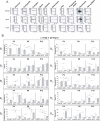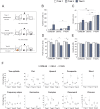Longitudinal analysis of ultrasonic vocalizations in mice from infancy to adolescence: Insights into the vocal repertoire of three wild-type strains in two different social contexts
- PMID: 31365551
- PMCID: PMC6668806
- DOI: 10.1371/journal.pone.0220238
Longitudinal analysis of ultrasonic vocalizations in mice from infancy to adolescence: Insights into the vocal repertoire of three wild-type strains in two different social contexts
Erratum in
-
Correction: Longitudinal analysis of ultrasonic vocalizations in mice from infancy to adolescence: Insights into the vocal repertoire of three wild-type strains in two different social contexts.PLoS One. 2019 Aug 15;14(8):e0221469. doi: 10.1371/journal.pone.0221469. eCollection 2019. PLoS One. 2019. PMID: 31415671 Free PMC article.
Abstract
Ultrasonic vocalizations (USV) are emitted by mice under certain developmental, social and behavioral conditions. The analysis of USV can be used as a reliable measure of the general affective state, for testing the efficacy of pharmacological compounds and for investigating communication in mutant mice with predicted social or communication deficits. Social and communication studies in mice have focused mainly on the investigation of USV emitted by neonatal pups after separation from the dam and during social interaction between adult males and females. Longitudinal USV analysis among the different developmental states remained uninvestigated. In our study, we first recorded USV from three inbred mouse strains C57BL/6N, DBA/2 and FVB/N during the neonatal stages after separation from the littermates and then during a reunion with one littermate. Our results revealed significant strain-specific differences in the numbers and categories of USV calls. In addition, the USV profiles seemed to be sensitive to small developmental progress during infancy. By following these mice to the adolescent stage and measuring USV in the three-chamber social test, we found that USV profiles still showed significant differences between these strains in the different trials of the test. To study the effects of social context on USV characteristics, we measured USV emitted by another cohort of adolescent mice during the direct social interaction test. To this end, this study provides a strategy for evaluating novel mouse mutants in behavioral questions relevant to disorders with deficits in communication and sociability and emphasizes the important contribution of genetics and experimental contexts on the behavioral outcome.
Conflict of interest statement
The authors have declared that no competing interests exist.
Figures




References
-
- Portfors CV. Types and functions of ultrasonic vocalizations in laboratory rats and mice. J Am Assoc Lab Anim Sci. 2007;46(1):28–34. . - PubMed
Publication types
MeSH terms
LinkOut - more resources
Full Text Sources
Molecular Biology Databases

